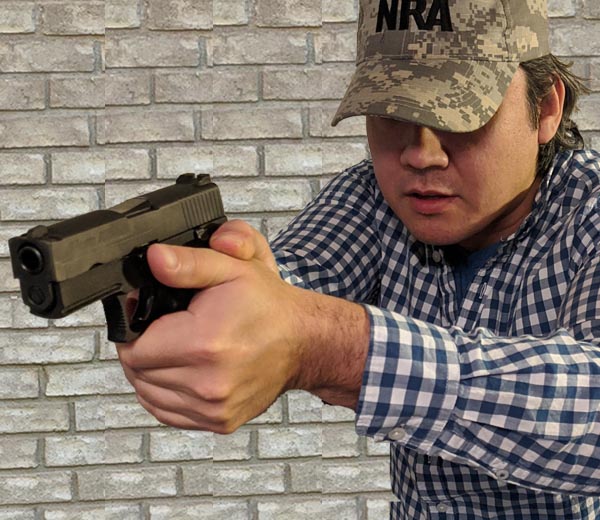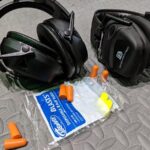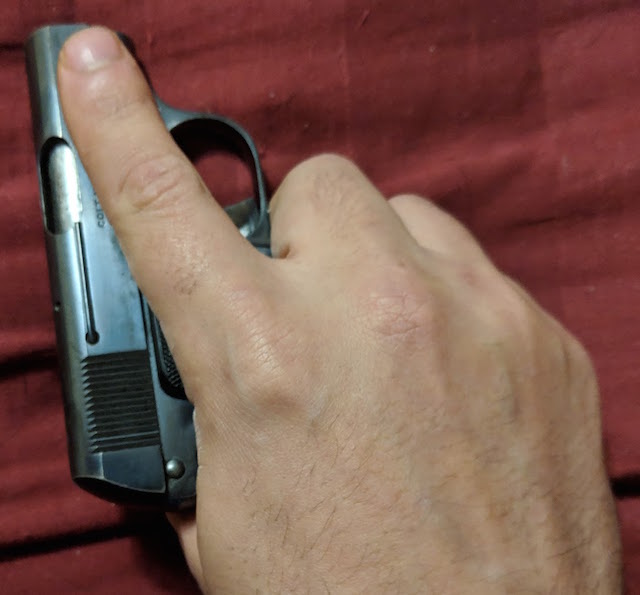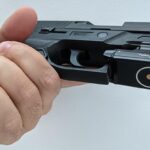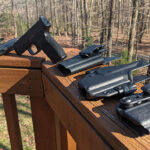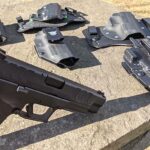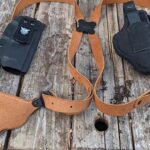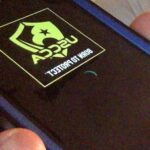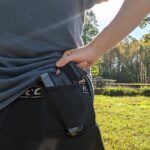Proper shooting technique starts with your setup. Among other things, your setup includes your shooting stance and how you grip your handgun. But what is the proper technique to grip a pistol for shooting accuracy? First, take the pistol in your dominant hand and squeeze all fingers tightly around the pistol grip. Ensure your trigger finger does not rest on the trigger until you are ready to shoot. Second, place your non-dominant hand over your dominant hand and squeeze with all of your finger, and squeeze your palms together. For an automatic, the thumb of your non-dominant hand should run along the frame of your pistol, below the slide. With a revolver, the thumb on your non-dominant hand should be tucked below the cylinder.
Table of Contents
Why You Should Use Two Hands To Grip The Pistol
Whenever possible, a shooter should use both hands to grip the pistol. The added strength of the additional hand and arm allow you to steady the firearm much easier. Because the firearm is steady, it will be much easier to achieve and maintain proper sight alignment. Additionally, using your second arm allows for better recoil management and mitigates muzzle hop when firing. Until you are familiar with the recoil of your firearm, and confident in your shooting abilities, you should refrain from attempting a one handed grip.
More experienced shooters may practice a one-handed grip to simulate scenarios where one hand has become non-operational or is being used for another purpose. Shooting with a one-handed grip makes target acquisition and recoil management more difficult. You will need extreme familiarity with the trigger pull and other characteristics of your pistol to shoot accurately with a one handed grip. Furthermore, you will need to train the muscles to handle the rigors of shooting to use a one handed grip successfully. Don’t believe the movie hype, it’s not as simple as the silver screen depicts.
Different Types Of Two Handed Grips
There are various different styles that shooters adopt when shooting. While there are slight variations, these changes can have a drastic impact on your shooting accuracy. Below is a list of the common two-handed grip styles. The most effective method for gripping a pistol is the thumbs forward method.
1. Thumbs Forward Grip
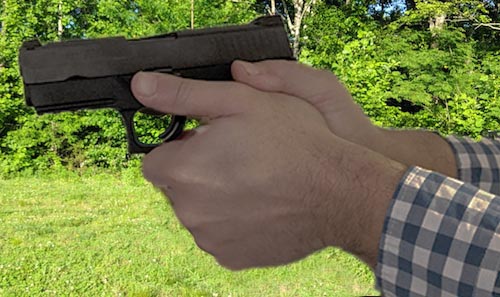
The thumbs forward grip is aptly named because the tops of both thumbs run down the frame, and point forward in the direction of the barrel. This method is described in more detail in the following section.
2. Tea Cup Grip
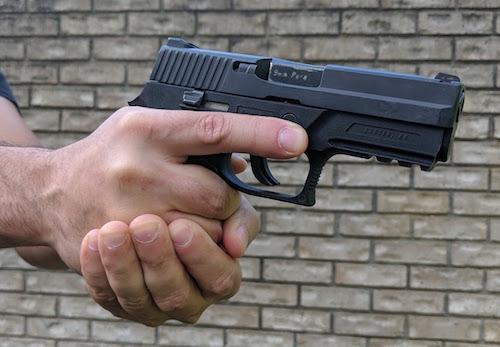
In my experience, this is the most common type of two-handed grip. For many, this method feels comfortable and provides adequate support to the shooting hand. Generally, the dominant hand maintains a firm grip on the pistol. The support hand is cupped below the dominant hand, and allows the shooter to easily elevate the shooting arm.
However, the support hand only passively provides assistance to the shooting hand. This method can assist with proper sight alignment, but is not effective in managing recoil. Because the support hand is supine, squeezing with the fingers on that hand may cause the muzzle to dip toward the side of the supporting hand.
3. Crossed Thumbs Grip
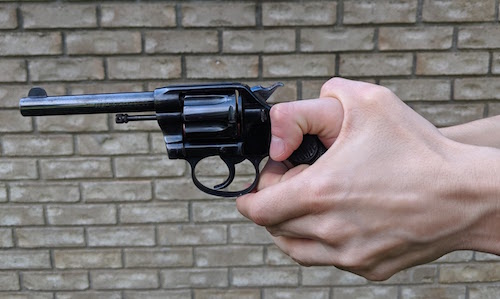
The crossed thumbs method seems most popular among revolver users. When gripping your pistol in this style, the fingers of the non-dominant hand overlap the hand grasping the pistol. The thumbs are interlaced with the shooting hand thumb on the bottom.
Crossing your thumbs while gripping an automatic pistol can result in injury when the slide recoils from discharging a round. Furthermore, your hands are completely positioned at the rear of the weapon, which can make managing muzzle hop difficult. While this method most closely mirrors the thumbs forward grip, it does require more forearm strength to keep the muzzle elevated for proper sight alignment.
4. Wrist Wrap Grip

The wrist wrap method is commonly used by shooters with weaker forearms and wrists. Shooters who use this style tend to have shots miss low on the target. To compensate, the shooter wraps their support hand around the wrist of the shooting hand to provide additional support.
While this grip on a pistol can assist with sight alignment, it is less effective than the thumbs forward grip when managing recoil. Because the shooters support hand is dedicated to keeping the wrist stiff, energy is transferred through the wrist joint down to the elbow. However, unlike the thumbs forward method this energy is mostly absorbed by a single arm rather than both arms.
Using Your Dominant Hand For The Thumbs Forward Grip
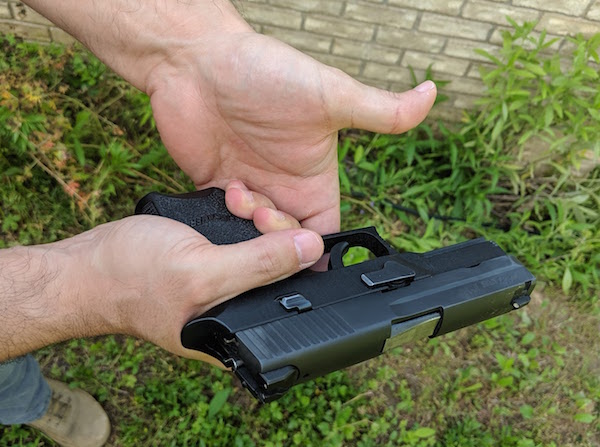
As you remove the pistol from your holster take the pistol grip (the handle) in your dominant hand. You’ll want to seat the back portion of the pistol grip into the crook between your thumb and index finger. The weapon should be pressed into the palm of your hand snugly. The thumb of your shooting hand will rest above your ring finger and the tip of your thumb should be pointed forward. As you practice this, it will become second nature.
Additionally, your index finger should remain off the trigger until your are ready to shoot. I rest my finger on the outside of the trigger guard, where it meets the frame. Your middle finger, ring finger, and pinky should grip the pistol firmly. Generally, your middle finger will be positioned just below the intersection of the trigger guard and pistol grip.
When using a revolver, the thumb on your dominant hand is responsible for cocking the hammer. It will temporarily leave it’s position in order to accomplish this, but should return prior to shooting.
How To Use Your Non-Dominant Hand In The Thumbs Forward Grip
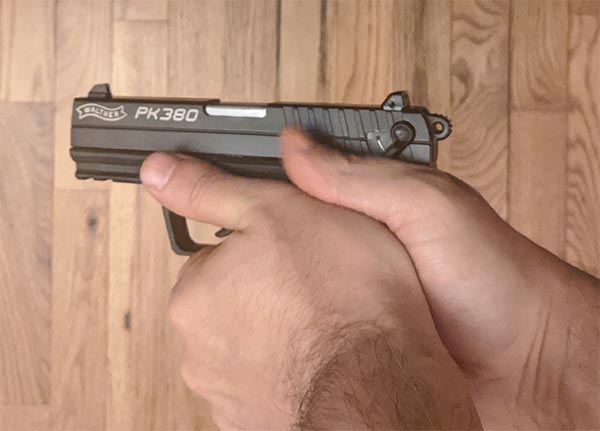
Many first time shooters use their non-dominant hand as a resting platform. They make a cup shape with their hand and seat the bottom of the pistol grip and their dominant hand into this. However, this technique is incorrect.
When using the thumbs forward pistol grip, place the non-dominant hand over top of your dominant hand (excluding the thumbs). Your index finger on your non-dominant hand should cover the middle finger of your dominant hand on the pistol grip. Push the palms of both hands together forcefully, and squeeze with both sets of fingers on the pistol grip.
For an automatic, the thumb of your non-dominant hand will run along the frame just below the slide when gripping the pistol. Pinch your thumb tight to the frame, do not let your thumb extend outward. Those with hitchhiker thumbs may find it easier to press the inner part of the knuckle for the first digit of their thumb against the frame instead.
When using a revolver, ensure that your thumb is tucked to not impede the motion of the cylinder. Generally, the thumb of your non-dominant hand will partially overlap that of your dominant hand.
Why Your Wrist And Forearms Are Important To Your Grip
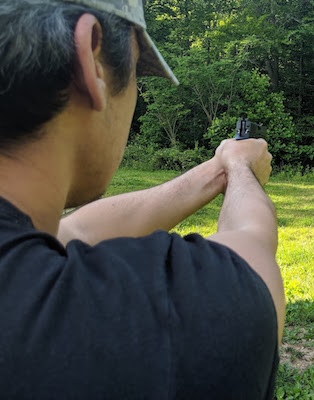
When learning how to grip a pistol, many shooters ignore their wrist and forearms. However, to shoot accurately, these are an integral part of how to grip the firearm. Once your hand placement is fixed, you’ll begin pushing out toward your target.
If you want to learn how to grip a pistol properly, you’ll need to mind your wrist. At this point, your wrist position is vital. Maintain a stiff wrist and keep it in line with your forearm. You should avoid excessive bend in your wrist for either hand, vertically or horizontally, when gripping your pistol.
Additionally, you want a slight bend in the elbow. Your forearm should be fully flexed from your tight grip on the pistol as well as pushing your palms towards each other. Part of learning how to grip a pistol is managing the recoil. Stiff wrists will allow the force from the discharge of a round to travel down the forearms to the larger elbow and shoulder joints. Additionally, the slight bend in your elbow will absorb the recoil, thus allowing for more accurate successive shots.
How To Cock The Hammer While Gripping The Pistol
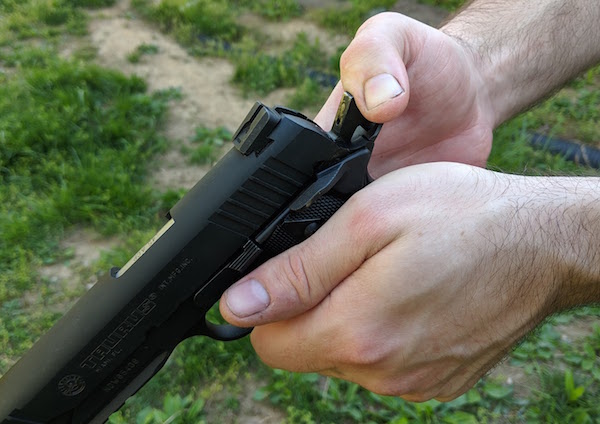
If you are using a revolver (or an automatic without a recessed hammer), you may find it difficult to grip the pistol and cock the hammer. Guns can be heavy, and revolvers are no exception. Therefore, you’ll need to grip the pistol firmly with the middle finger, ring finger, and pinky on your dominant hand. Furthermore, your weak side (non dominant hand) will provide support for your grip while you cock the hammer.
When you cock the hammer, you’ll need to adjust your grip to allow for movement of the thumb on your dominant hand. Because your other thumb is covering the dominant hand, you’ll need to temporarily move it, to allow your dominant thumb to move to the hammer. You can then place it on the side of the firearm for added stability while you cock the hammer. Tipping the muzzle of the weapon downward can provide additional leverage to cock the hammer if you have difficulty keeping the barrel level.
Once you have cocked the hammer, return your thumbs to the original position, and resume the standard grip for shooting described above. Remember, keep your finger off the trigger during the entire process. The act of cocking the hammer on a pistol converts the trigger from double action (cocking and releasing the hammer) to single action (releasing the hammer only).
How Hard Should I Grip The Pistol?
Regardless of whether you are using a one or two hand grip on the pistol, how tightly you grip the pistol has a direct correlation to accuracy. You should grip the pistol as hard as you can without causing the muzzle to shake. Squeeze tightly with all fingers, including the pinky. This will assist in keeping the muzzle level and the dots on your sights aligned. Imagine there is a winning lottery ticket grasped between both hands.
If you are using a support hand to grip the pistol, use the heels of your palms to create a vice by driving them inward towards one another. Avoid applying unequal pressure with the palms as this can cause your shots to deviate laterally. Additionally, drive the elbows inward to assist when pushing out toward your target. This will help press the palms inward towards each other and increase your grip on the pistol.
Advanced Shooters: Gripping The Pistol With One Hand
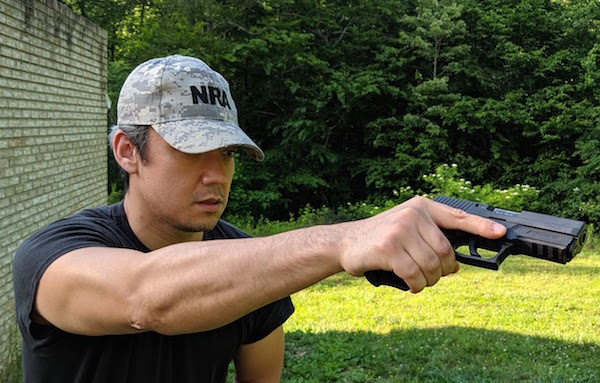
New shooters should focus on the thumbs forward technique listed above to develop their two-handed grip before moving on to shooting with one hand. However, for those who desire to shoot one handed, here are some techniques that can assist.
Grasping The Pistol One-Handed
Your shooting hand will need to follow many of the guidelines set forth in the two hand grip. The pistol should be seated snugly into the palm of your hand. You should be squeezing with all of your fingers on the pistol grip. However, instead of pointing the thumb forward, tuck the thumb on top of the middle finger to seal the grip.
The wrist of your shooting hand should be stiff, and your arm should be extended with a slight bend in the arm to manage the recoil.
Adjusting The Angle Of The Gun
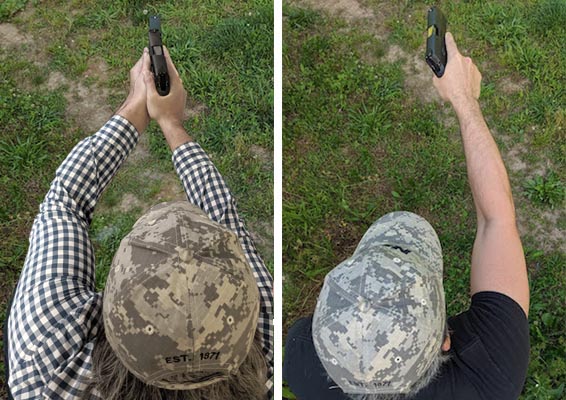
Keeping your wrist stiff, and inline with your forearm, while pushing out from the center of your body can be difficult. This is especially true when using only one hand. To alleviate pressure on your wrist, you may need to angle the pistol slightly. This is referred to as pistol cant. To achieve proper pistol cant, rotate the hand gripping your pistol inward toward the center line of your body. The greater that cant of your weapon, the closer to horizontal the weapon becomes.
I recommend keeping your cant to a minimum, as shooting a pistol horizontally can be difficult to aim properly. As you increase your cant, the elbow of the shooting arm will move outward from the center line of the body. Your wrist and arm should be flexed, with a slight bend at the elbow.
Exercises To Develop Grip Strength to Hold The Gun Steady
Shooters who have difficulty with accuracy due to grip strength are usually prone to weakness in one of three areas. First, the shooter lacks sufficient hand strength to grip the pistol and keep it stationary within their hand. Another common problem area is insufficient forearm strength to keep the muzzle elevated and manage recoil. Finally, and less common is a weakness of the shoulder muscles to keep the arms extended under load. Fortunately, if you are having problems keeping the gun steady there are exercises you can do to develop those muscle groups.
Developing Grip Strength To Keep The Pistol Steady
Developing hand strength for a better grip on your pistol can be achieved using many different grip strength tools on the market. This grip strengthening kit on Amazon provides several tools for developing your grip. Use the finger strengthening tool to develop the ring and pinky fingers, which is usually where strength is lacking. For overall grip strength, you can squeeze the stress ball.
When using any grip strengthening tool, you should perform a minimum of 3 sets of 20-25 repetitions. Make sure you get full extension between reps. To increase the difficulty, perform an isometric hold to mimic the sustained tension required to grip a pistol.
Increasing Forearm Strength To Improve Grip
One simple method to develop forearm strength to grip a pistol involves a 5-10 pound dumbbell. There are 3 exercises you can do to develop your forearm to improve your handle on your pistol.
First, grasp the dumbbell in your shooting hand with your palm facing up and forearm parallel to the ground. Let your wrist hang limp, then flex your wrist bringing the palm of your hand toward your elbow joint. Perform 3 sets of 20-25 repetitions in this direction.
Next, use a pronated grip on the dumbbell (palm facing down) and your arm parallel to the ground. Perform the same amount of sets and reps going in the opposite direction. To increase difficulty do not support your forearm while doing the exercise.
Finally, grasp the dumbbell with a neutral grip with both hands. Keep the dumbbell at the center line of your body. Extend your hands outward from the center line of your body while gripping the dumbbell. Hold your arms extended for a 5 second count, and do this for 20-25 repetitions. This exercises has the added benefit of developing weak shoulder joints as well.
Accessories To Improve Your Grip
I encourage every shooter to take time to develop their grip muscles and technique. However, if you have done all you can to develop your grip strength and still struggle, there are modifications you can make to your pistol to help steady your aim.
Rubber Molded Pistol Grips
If you have difficulty gripping your pistol due to sweaty hands, then rubber grips may be necessary. Additionally, many rubber pistol grips are molded to fit the contour of your closed hand around the pistol grip. The rubber will not slip from the handle and may offer more comfort to those with weaker hands.
Hogue grips are one of the better-known names in the industry. You can find a listing of many of their offerings on Amazon. You’ll need to ensure the model of rubber grip you choose fits your pistol. Whether it is a full-size automatic or a revolver, chances are that Hogue has a grip for your pistol.
Grip Tape
Another great option to enhance your grip, is grip tape. This material is similar to what is found on skateboards. Users with sweaty hands can benefit from the rough texture to help keep a grip on their pistol. Unlike the rubber molded grips mentioned above, you will need to cut this to fit your handgun.
Because the material is so coarse, it will dull and ruin a pair of scissors. Therefore, I recommend that you purchase a pair solely for this purpose. The great thing about grip tape, is that you can size it to fit your needs. I recommend placing a small piece on the frame where your support hand thumb rests to assist with consistent hand placement.
This is the most cost effective way to improve your grip, though it will take some work. A 6-inch wide strip of grip tape is sufficient for covering your pistol grip. You can find grip tape of various widths on Amazon for relatively cheap.
Parting Shots
Learning how to grip a pistol isn’t just about your hands. You’ll need to squeeze with every muscle fiber in your forearms to aim accurately. Furthermore, you’ll need to maintain a stiff wrist. When gripping the pistol, ensure you are squeezing with both sets of fingers as well as pushing your palms together. Thumbs should remain out of the way of any action on the pistol and tight to the grip or frame depending on the type of pistol you are shooting. Do you have a different technique for how to grip a pistol properly? Feel free to leave a comment with tips others might be able to use.
